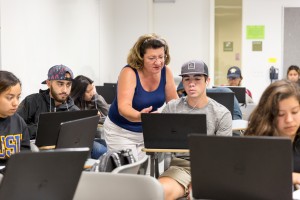Last week’s tip described some fairly simple things you can do to help students (and you) monitor what they were learning and where they were having difficulties. This week’s tip focuses on ways to help students recognize how they learn best so that they can feel (and truly be) more in control of their academic success. As many researchers have demonstrated:
- In addition to getting better grades and learning more, students who know what they need to do to do well at their academic tasks are more willing to try hard and persevere when the material is challenging, and to really invest themselves in their academic environment
- Students who are not confident that they know what they need to do to ensure their success are less likely to feel comfortable engaging fully in their course. Instead they are more likely to “phone it in”, to pull back, and as a result, sabotage their own learning. Furthermore, their negative affect and attitude can undermine your efforts to create a vibrant learning environment
- Reflecting on their own experience and comparing notes with classmates can lead to very powerful – and empowering – insights for students
- And finally, thinking about your students’ insights can provide you with information to share with future students, as you provide guidance to them about ways to get the most from your courses
Faculty Matter Teaching Tip #6
Helping students to become better self-regulated learners. By now you and your students have likely settled into the rhythm of the semester. It’s a perfect time to introduce an activity to help students monitor how they learn best.
Ask them to complete the following inventory (or something similar), sharing their answers with you or with each other in small groups, and then making a specific plan for how they will study for your class for the next three weeks (or up through a particular assignment or exam). As a follow-up, have them revisit their plan, and reflect (in writing, or in conversation with you or with classmates) about what they have discovered about how they might best manage their own learning. (Note, the learning inventory below is written with respect to reading but you can adapt this to be more relevant to your class such as with a focus on solving problems or writing.)
Think about the studying you do for this class. Can you find a pattern? Begin by thinking about occasions where things go well.
- Begin by thinking about occasions where things go well?
- When are you best at truly understanding what you read and remembering what you study: First thing in the morning? In the afternoon? In the evening? Late at night? After a nap or a good night’s sleep? After a meal? After a workout or exercise? Other? How long can you focus on what you are studying before you feel tired, distracted, bored or like you have reached your limit of productivity?
- Where are you best at truly understanding what you read and remembering what you study: At home or in your room? At a coffee shop? In the library? In silence? With background noise or music? Alone? With one study partner? With a group of people? Sitting in a comfortable seat? Lying down? At a table? Other?
- How are you best at truly understanding what you read and remembering what you study: Underlining or highlighting passages while you read? Taking notes while you read? Answering study guide questions while you read? Creating pictures, maps, charts or other kinds of “graphic organizers”? Reading out loud? Other? How do you make use of your class notes? What do you do when you encounter a reading passage that is hard to understand or a place where your notes are unclear or incomplete?
- Now think about a time or two where you didn’t do as well as you usually do at understanding or remembering material you were trying to learn. Look back at your answers to the questions above, and think about how your approach in those positive situations was different from your approach when things didn’t go as well.
- Commitment to self: Now that you have identified a “pattern for success”, list one to three specific changes you will make to the way you study, implement those changes, and check back in a few weeks to see how your efforts have made a difference in how much you are enjoying and learning in your classes.
Additional information and resources about Self-Regulated Learning:
Fact-Sheet about Self-Regulated Learning (https://teal.ed.gov/tealguide/selfregulated)
The Secret of Self-Regulated Learning (http://www.facultyfocus.com/articles/teaching-and-learning/secret-self-regulated-learning/)
Please add your own strategies using the comment link below.
